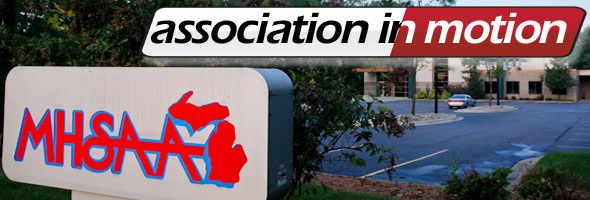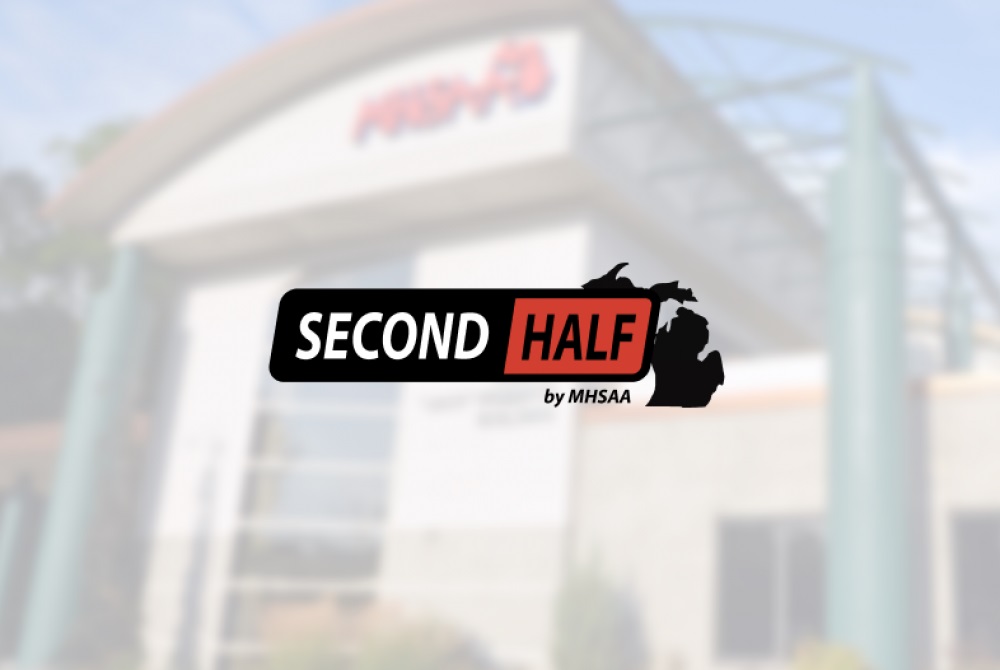
Rep Council Wrap-Up: Spring 2015
May 11, 2015
By Geoff Kimmerly
Second Half editor
The Representative Council of the Michigan High School Athletic Association took a number of significant actions during its annual Spring Meeting, May 3-4, in Glen Arbor, highlighted by changes to out-of-season coaching rules, a call for a member vote on a Constitutional amendment affecting middle school and junior high athletics, and initiatives to promote participant health and safety.
The Spring Meeting of the 19-member legislative body of the Association’s more than 1,400 member schools is generally the busiest of its three sessions each year. The Council considered 13 committee proposals and also dealt with a variety of eligibility rule, postseason tournament and operational issues.
For the past eight months, the MHSAA focused member schools’ attention on an overhaul of out-of-season coaching rules. While support was lacking for a radically different approach, consensus developed for several significant changes within the existing approach for expanding contact between school coaches and their students out-of-season during the school year.
Included in the changes are that coaches will be permitted to work with up to four players in all situations out-of-season during the school year; previously, coaches could work with three or four players, depending on the circumstance. Coaches also will be allowed out of season during the school year to provide coaching in non-school competition to up to four students from that coach’s school. Under this same set of out-of-season coaching rules during the school year, the Council permitted more contact among school coaches and students allowing for previously banned offseason practice rotations to occur. Voluntary workouts out-of-season that involve rotations from conditioning, open gyms, weight lifting and sport-specific skill work may occur so long as there is no more than one four-player station with sport skills being coached.
Following up on more than a year of consideration by the MHSAA Junior High/Middle School Committee and a Junior High/Middle School Task Force created in December 2013, the Council also approved a request for a membership vote to amend the MHSAA Constitution to allow for school membership beginning at the 6th grade. The membership vote is expected to be conducted in late October; if membership approves the amendment, the Council will consider for which sports 6th-graders will be eligible to compete with and against 7th- and 8th- graders.
The MHSAA’s historical concern for health and safety has been intensified during the past six years of an eight-year campaign focused on “4 H’s” – Health Histories, Heads, Heat and Hearts – and the Council approved several initiatives which continue to improve the environment of school-based sports.
The Council authorized up to three pilot programs to be conducted by volunteer schools, aimed at assisting in decision-making regarding the removal of athletes from activity after possible concussion events as well as in reporting and record-keeping of those events.
The Council mandated that member schools report head injury events through a web-based reporting system the MHSAA is developing. The Council also approved the purchase of another level of insurance aimed at assuring that children of uninsured or underinsured families receive prompt and professional care for suspected head injuries. Both the reporting requirement and the insurance protection are for eligible athletes in all levels of all sports, grades 7 through 12, in both practices and competition.
The Council was briefed on an electronic system that could be used to track pre-participation physical examination forms while improving injury reporting and record-keeping; currently, the MHSAA provides paper forms to member schools at no charge. The Council also was updated on MHSAA plans to provide at no cost to every high school in Michigan the ANYONE CAN SAVE A LIFE – Emergency Action Planning Guide, and informed on the MHSAA’s support of the MI HEARTSafe School initiative of the Michigan Department of Health and Human Services, which on May 13 will recognize 128 schools and/or districts for cardiac emergency preparedness.
Here is a summary of other actions taken by the Representative Council at the Spring Meeting, which will take effect during the 2015-16 school year:
Handbook/Administrative Matters
- Participation was expanded by the Council for 9th- and 10th-grade transfer students with no history of high school athletic participation who gain immediate subvarsity eligibility through a waiver by the MHSAA Executive Committee. Students who are granted such a waiver may now participate in designated non-scoring subvarsity heats or non-scoring races of varsity individual contests in sports such as swimming and diving, cross country and track and field. Previous to this action, subvarsity eligibility was permitted in subvarsity team sports only or subvarsity-only meets in individual sports. The subvarsity definition also will apply to international students present in the U.S. on an F-1 Visa but not from an MHSAA-approved international student program.
- Athletes in ice hockey and boys and girls soccer must compete in four regular-season games against other MHSAA schools to be eligible to compete with their school teams in the MHSAA Tournament. This currently is a requirement in alpine skiing, and a waiver procedure similar to what is utilized in skiing will be developed for hockey and soccer as well.
- Non-school sports activities coordinated or directed by administrators and parents were added to situations which trigger an athletic link and an extended period of ineligibility for transfer students if those students then enroll at new schools that have association with those administrators or parents. The Council expanded the athletic-related transfer rule which previously involved only non-school coaches and transferring students who do not make a residential change.
Classification
- The Council created a “life line” allowance for schools to form a cooperative agreement in excess of the 3,500-student enrollment cap in sports sponsored by fewer than 250 schools. A program may be approved by the Executive Committee for up to three years, if during the previous year, the school or the cooperative program in which the school was a part dropped the sport because of a demonstrated lack of participation. Sports sponsored by 250 or fewer schools during 2014-15 were gymnastics, ice hockey, boys and girls lacrosse, boys and girls alpine skiing and boys and girls swimming and diving. This three-year “life line” allowance is similar to the regulation which allows for a “startup” cooperative program to be created among schools whose combined enrollment exceeds 3,500 students but the schools involved did not sponsor the sport in the previous school year.
Sport Matters
- For boys and girls basketball, the Council approved an MHSAA Basketball Committee recommendation to seek permission from the National Federation of State High School Associations (NFHS) to allow teams to play up to two regular-season games made up of 18-minute halves instead of the current 8-minute quarters. If permission is granted by the NFHS, schools will be required to seek permission from the MHSAA prior to events and provide reports after 36-minute games are played.
- In bowling, it was announced that Kegel is developing a bowling lane oil pattern for high school bowling called the “Allen Pattern,” named after former MHSAA Assistant Director Randy Allen, who administered the MHSAA bowling program from its inception during the 2003-04 school year until retirement in 2013. Michigan has the largest number of schools in the U.S. sponsoring interscholastic bowling. The Allen Pattern is being designed specifically for the high school level and will be utilized for the 2016 MHSAA Bowling Tournament.
- In cross country, the MHSAA will appoint and administer a task force of coaches and athletic administrators to address unbalanced Lower Peninsula Cross Country Regionals – including some Regionals having more complete teams in competition than others because teams decide to not compete or cannot compete with a full lineup after Regional groups are drawn. The task force will present its findings to the Council in 2016.
- For ice hockey, four-person officiating crews were approved for Quarterfinals. The MHSAA began using four-person crews for Semifinals and Finals in 2014.
- In boys lacrosse, a “play in” game was approved for teams seeded 9-16 in each Regional. Play-in games will be played three days earlier than the traditional start of the MHSAA Tournament, with winners then playing teams seeded 5-8 at the traditional start of tournament play.
- In wrestling, the Council approved a recommendation by the MHSAA Wrestling Committee that eliminates the second weigh-in at the MHSAA Team Finals. The Friday weigh-in before the start of Quarterfinals will be used for all three rounds of competition during Finals weekend.
The Council also reviewed reports on membership, with 754 senior high schools and 703 junior high/middle schools in 2014-15; eligibility advancement applications, which totaled four for the year; the use of Educational Transfer Forms, which held steady this year; school violations, attendance at athletic director in-service workshops and Coaches Advancement Program sessions, officials’ registrations, rules meetings attendance and officials reports submitted for the past three sports seasons. The Association’s $10.4 million budget for the 2015-16 school year also was approved.
The Representative Council is the 19-member legislative body of the MHSAA. All but five are elected by member schools. Four members are appointed by the Council to facilitate representation of females and minorities, and the 19th position is occupied by the Superintendent of Public Instruction or designee.
The MHSAA is a private, not-for-profit corporation of voluntary membership by more than 1,400 public and private senior high schools and junior high/middle schools which exists to develop common rules for athletic eligibility and competition. No government funds or tax dollars support the MHSAA, which was the first such association nationally to not accept membership dues or tournament entry fees from schools. Member schools which enforce these rules are permitted to participate in MHSAA tournaments, which attract more than 1.4 million spectators each year.

MHSAA Announces Revised Format for 2021 Bowling Tournaments
By
Geoff Kimmerly
MHSAA.com senior editor
February 26, 2021
The Michigan High School Athletic Association has revised its 2021 girls and boys Bowling Regionals and Finals, scheduled for next month, in an effort to reduce the mixing of communities and spread of COVID-19.
Regional competition, traditionally a two-day event with team competition Friday and singles Saturday, will be a two-day competition still but with boys competing Friday, March 19, and girls Saturday, March 20. Instead of bowling separate competitions to determine qualifiers for the team and singles Finals, all Regional participants will bowl four regular games on their designated day, with those scores determining the Finals qualifiers for both formats.
No Baker games will be rolled at Regionals; instead, 20 regular games will be counted toward a team’s score. Those 20 regular games may be bowled four each by five bowlers or subs, with the maximum of four games per bowler. A bowler must roll four games to qualify for Finals in singles.
Two teams – instead of the traditional three – and 10 singles will advance to the MHSAA Finals to be bowled March 26-27. At the Finals, teams will compete Friday and singles Saturday, as in the past. The 10 singles qualifiers from Regionals also is the same number as usual. At the Finals, the traditional scoring for team competition of regular and Baker games, with qualifying and match play, will continue to be used.
Bowling the boys and girls on separate days for Regionals will allow host bowling centers to spread competitors out among twice as many lanes. Fewer team qualifiers for Finals also will limit congestion at those four sites.
Spectator limits at Regionals and Finals will be determined locally following Michigan Department of Health and Human Services orders and fire marshal capacity limits at centers. Spectators will not exceed one per participant.

